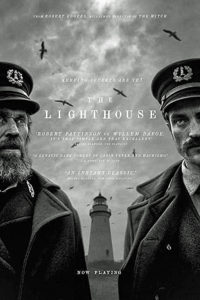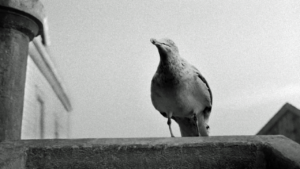 By Steve Crum
By Steve Crum
After spending 109 minutes watching The Lighthouse, the film’s message persists: “It’s bad luck to kill a seabird!” I so believe it now, as it is uttered early in the movie by Thomas Wake (Willem Dafoe). Wake’s warning to Robert Pattinson’s Ephraim Winslow tragically goes unheeded.
Directed and co-written by Robert Eggers (along with co-writer/brother Max), The Lighthouse is a highly original but grim motion picture on several levels. This psychological horror drama, released last October, is jammed with nightmarish imagery and tour de force acting (Dafoe and Pattinson are its only two actors). Both actors perform awesomely.
Besides the actors, there are enough auditory devices to fill several films. I speak of surround sound effects such as seagulls, heavy rain, and the damned foghorn that nearly affected me as much as it does the pitiful Winslow character. Both he and Wake are lighthouse keepers, arriving at the story’s opening to replace two others we see departing. The job calls for four weeks tending the remote lighthouse, whereupon they will be replaced. It is telling that neither duo says anything to the other as they pass by. Not even a nod or gesture.
 Once settled in, it becomes clear these two are total strangers who now have to work together for a month. The emphasis here is the “strange” in strangers. Dafoe’s older, bearded Wake immediately takes charge as sole keeper of the lighthouse, while delegating all menial labor chores to Pattinson’s Winslow. To make it worse, his hard work is repeatedly criticized by his new boss. Wake repeatedly orders that the floor scrubbing be done over and over. He is rarely satisfied with the results. It does not take long before Winslow revolts at his slave labor treatment.
Once settled in, it becomes clear these two are total strangers who now have to work together for a month. The emphasis here is the “strange” in strangers. Dafoe’s older, bearded Wake immediately takes charge as sole keeper of the lighthouse, while delegating all menial labor chores to Pattinson’s Winslow. To make it worse, his hard work is repeatedly criticized by his new boss. Wake repeatedly orders that the floor scrubbing be done over and over. He is rarely satisfied with the results. It does not take long before Winslow revolts at his slave labor treatment.
Four months into their job, Winslow is still not permitted to even step into the beacon tier of the lighthouse. Wake keeps it locked tight.
 All this said, and without divulging more plot development, things hit the proverbial fan when their relief ship fails to show up with replacements. By that time, their booze-filled world of isolation is compounded by a terroristic seagull, bloody water, and a scary mermaid.
All this said, and without divulging more plot development, things hit the proverbial fan when their relief ship fails to show up with replacements. By that time, their booze-filled world of isolation is compounded by a terroristic seagull, bloody water, and a scary mermaid.
This study in paranoia, terror and insanity is somewhat adapted from the unfinished short story, The Light-House, by Edgar Allen Poe.
Mention must be made that it was shot in gorgeous black-and-white, enhancing the atmosphere. And it is not in widescreen. Realizing the movie is set in the late 19th Century, let us hope the pandemic quarantine we are all going through now never results in what occurs in The Lighthouse.
![]() Plaudits to Jarin Blaschke’s stunning cinematography, which was Oscar nominated earlier this year.
Plaudits to Jarin Blaschke’s stunning cinematography, which was Oscar nominated earlier this year.
The wild finale brought to mind three classic films: Kiss Me Deadly (1955), 2001: A Space Odyssey (1968), and The Birds (1963). See The Lighthouse to believe it.
=====
GRADE, On A to F Scale: A-
